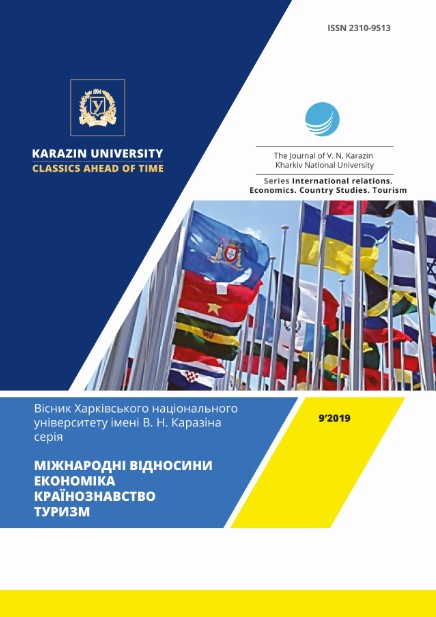Perspectives for improving the life level of the population of the South African Republic in the context of the membership in the BRICS
Abstract
The article is devoted to the study of socio-economic problems in South Africa, as well as current and perspective measures for their solving within the BRICS membership. The subject of the study is the life level of the population of South Africa. The goal is to identify the perspectives for South Africa solving the problem of poor quality of life for an absolute majority of the population due to its membership in BRICS. The objective is to examine poverty and Gini coefficients, unemployment, condition and problems of education, data on AIDS and tuberculosis rates in South Africa and other BRICS member countries, and also to identify planned activities within the framework of BRICS for these problems solving. General scientific methods such as analysis, synthesis and comparisons are used in the article. The following results were obtained: after the abolition of apartheid policy some indicators in South Africa have improved (rates of GDP per capita, availability of education and life expectancy have increased, more people got access to the Internet and electricity). However, significant problems remained – high unemployment, unskilled work force, huge rates of uneven income distribution, violence, high rates of AIDS and tuberculosis. Having examined the BRICS summit declarations, we have found that member countries are paying considerable attention to the development of political methods for dealing with national problems. Some of the issues have already been solved by certain members of the BRICS, while others are still common. Conclusions: BRICS planned activities aimed at solving the problems of poverty, unemployment, education, incidence of tuberculosis and AIDS have been indicated; we believe that if the ambitious goals of repositioning geopolitical forces in the world attributable to BRICS are real, the union can’t allow any member to "turn a blind eye" to problems that are well-known and spoil the social reputation in the global space, not only for the problematic country, but also for the whole union, and therefore South Africa has all chances to solve its basic social problems.
Downloads
References
Analiticheskiy tsentr pri pravitelstve Rossiyskoy Federatsii. (2018). Byulleten o tekuchikh tendentsiyakh mirovoy ekonomiki. YuAR: uspekhi i problemy razvitiya. Vzyato s http://ac.gov.ru/files/publication/a/15766.pdf
BRIKS. (2017). Deklaratsiya ministrov truda i zanyatosti gosudarstv-chlenov BRIKS. Vzyato s https://www.ranepa.ru/images/media/brics/china2016/labour_2017.pdf
Vsemirnaya organizatsiya zdravookhraneniya. (19 sentyabrya 2018). Tuberkulez. Vzyato s http://www.who.int/ru/news-room/fact-sheets/detail/tuberculosis
Ganzha, A. (2018, avgust 30). «Golodnyy» Yug protiv «zhirnogo» Severa. BRIKS: rastushchiy bambuk. Informatsionnoe agenstvo REGNUM. Vzyato s https://regnum.ru/news/2473048.html
Gostev, A. (2017). YuAR pervye po iznasilovaniyam. Radio Svoboda. Vzyato s https://ru.krymr.com/a/28669396.html
Mikhalchenkova, N. A. (2017). Reformy vysshego obrazovaniya v stranakh BRIKS: vesternizatsiya ili poisk sobstvennogo puti? Vlast, 7, 166-173.
Moskva RIA Novosti. (2017). Indiya i Rossiya tratyat na obrazovanie menshe ostalnykh stran BRIKS. Vzyato s https://ria.ru/world/20171114/1508819382.html
Russkoe agentstvo. (2018). Sistema obrazovaniya v YuAR. Vzyato s https://diplomabroad.ru/yuar/istema_obrazovaniya_v_yuar/
Torgovoe predstavitelstvo RF v YuAR. (2017). Godovoy obzor sostoyaniya ekonomiki i osnovnykh napravleniy vneshneekonomicheskoy deyatelnosti YuAR za 2016 god. Vzyato s http://91.206.121.217/TpApi/Upload/350d79fa-999d-414e-a59f-1c142aeeb18b/obzor_economy_SA_2017.pdf
Shubin, V. (2013). Zachem Yuzhnoy Afrike BRIKS i zachem BRIKSu Yuzhnaya Afrika. Indeks bezopasnosti, 2 (105), T.19, 57-70.
YuNЄYDS. (2016). Strany BRIKS podcherkivayut neobkhodimost v rasshirenii sotrudnichestva i prinyatii aktivnykh mer borby s VICh i tuberkulezom. Vzyato s http://www.unaids.org/ru/resources/presscentre/pressreleaseandstatementarchive/2016/october/20161017_BRICS
BBC News. Russkaya sluzhba. (2013, mart 15). Bolee chetverti shkolnits v YuAR zarazheny VICh. Vzyato s https://www.bbc.com/russian/international/2013/03/130314_south_africa_hiv_shoolgirls
Daniel, Workmen. (2018). South Africa’s Top 10 Exports. Retrieved from http://www.worldstopexports.com/south-africas-top-10-exports/
Euler, Hermes. (2018). South Africa. Country Risk Report. Retrieved from https://www.eulerhermes.com/en_global/economic-research/country-reports/South-Africa.html.
Johannes, C. Jordaan. (2016). An estimation of the impact of the 2012 platinum-sector strike on the South African Economy. South African Journal of Economic and Management Sciences, 19, 302-320.
Priviledge, Cheteni, Gisele, Mah, & Yohane, Khamfulaю, Yohane. (2018). Drug-related crime and poverty in South Africa. Cogent Economics & Finance. Retrieved from https://doi.org/10.1080/23322039.2018.1534528
Seán, Mfundza, Muller. (2018). Free higher education in South Africa: cutting through the lies and statistics. The Conversation. Retrieved from https://theconversation.com/free-higher-education-in-south-africa-cutting-through-the-lies-and-statistics-90474
Statistics South Africa. (2017). Education Series Volume III: Educational Enrolment and Achievement, 2016. Retrieved from http://www.statssa.gov.za/publications/Report%2092-01-03/Report%2092-01-032016.pdf
Statistics Times. (2018, May 06). List of Countries by Projected GDP per capita. Retrieved from http://statisticstimes.com/economy/countries-by-projected-gdp-capita.php
Tebogo, Tshwane. (2018, Feb 21). Finally: How government plans to fund free education. Mail& Guardian. Retrieved from https://mg.co.za/article/2018-02-21-finally-how-government-plans-to-fund-free-education
U.S. News. (2018). Quality of Life Rankings. Retrieved from https://www.usnews.com/news/best-countries/quality-of-life-full-list
World Bank. (2018). GINI index (World Bank estimate). Retrieved from https://data.worldbank.org/indicator/SI.POV.GINI?locations=BR-CN-RU-ZA
World Bank. (2018). Poverty headcount ratio at national poverty lines (% of population). Retrieved from https://data.worldbank.org/indicator/SI.POV.NAHC?locations=AF-BR-CN-IN-RU-ZA
Authors who publish with this journal agree to the following terms:
- Authors retain copyright and grant the journal right of first publication of this work under the terms of a license Creative Commons Attribution License 4.0 International (CC BY 4.0).
- Authors are able to enter into separate, additional contractual arrangements for the non-exclusive distribution of the journal's published version of the work (e.g., post it to an institutional repository or publish it in a book), with an acknowledgement of its initial publication in this journal.
- Authors are permitted and encouraged to post their work online (e.g., in institutional repositories or on their website) prior to and during the submission process, as it can lead to productive exchanges, as well as earlier and greater citation of published work.




